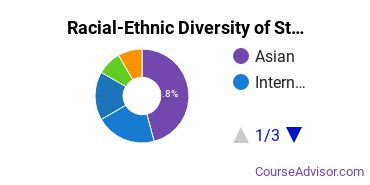Statistics at Hunter College
Hunter is located in New York, New York and approximately 24,052 students attend the school each year. Of the 3,597 students who graduated with a bachelor’s degree from Hunter College in 2021, 19 of them were statistics majors.
Want to know more about the career opportunities in this field? Check out the Careers in Statistics section at the bottom of this page.
Featured schools near , edit
Hunter Statistics Degrees Available
- Bachelor’s Degree in Stats
- Master’s Degree in Stats
Hunter Statistics Rankings
The following rankings from College Factual show how the stats progam at Hunter compares to programs at other colleges and universities.
Note: Rankings don't always give a complete picture of a school's strengths and weaknesses, so it's a good idea to extend your research and also look at other factors when trying to decide if the school is right for you.
Bachelor’s Degree Overall Quality & Other Notable Rankings
The stats major at Hunter is not ranked on College Factual’s Best Colleges and Universities for Statistics. This could be for a number of reasons, such as not having enough data on the major or school to make an accurate assessment of its quality.
| Ranking Type | Rank |
|---|---|
| 60 | |
| Best Value Statistics Schools | 77 |
In 2021, 24 students received their master’s degree in stats from Hunter. This makes it the #42 most popular school for stats master’s degree candidates in the country.
Stats Student Demographics at Hunter
Take a look at the following statistics related to the make-up of the stats majors at Hunter College.
Hunter Statistics Bachelor’s Program

Prospective students may be interested in knowing that this school graduates 18% more racial-ethnic minorities in its stats bachelor's program than the national average.*
The following table and chart show the race/ethnicity for students who recently graduated from Hunter College with a bachelor's in stats.

| Race/Ethnicity | Number of Students |
|---|---|
| Asian | 6 |
| Black or African American | 0 |
| Hispanic or Latino | 2 |
| White | 5 |
| International Students | 6 |
| Other Races/Ethnicities | 0 |
Hunter Statistics Master’s Program

In the stats master's program at this school, racial-ethnic minorities make up 63% of degree recipients. That is 38% better than the national average.*
The following table and chart show the race/ethnicity for students who recently graduated from Hunter College with a master's in stats.

| Race/Ethnicity | Number of Students |
|---|---|
| Asian | 11 |
| Black or African American | 2 |
| Hispanic or Latino | 2 |
| White | 4 |
| International Students | 5 |
| Other Races/Ethnicities | 0 |
Hunter also has a doctoral program available in stats. In 2021, 0 student graduated with a doctor's degree in this field.
Related Majors
Careers That Stats Grads May Go Into
A degree in stats can lead to the following careers. Since job numbers and average salaries can vary by geographic location, we have only included the numbers for NY, the home state for Hunter College.
| Occupation | Jobs in NY | Average Salary in NY |
|---|---|---|
| Mathematical Science Professors | 4,700 | $105,070 |
| Actuaries | 2,320 | $150,950 |
| Natural Sciences Managers | 1,360 | $148,460 |
| Statisticians | 1,120 | $95,870 |
| Survey Researchers | 710 | $74,130 |
References
*The racial-ethnic minorities count is calculated by taking the total number of students and subtracting white students, international students, and students whose race/ethnicity was unknown. This number is then divided by the total number of students at the school to obtain the racial-ethnic minorities percentage.
- College Factual
- National Center for Education Statistics
- O*NET Online
- Image Credit: By Beyond My Ken under License
More about our data sources and methodologies.
Featured Schools
 Request Info
Request Info
|
Southern New Hampshire University You have goals. Southern New Hampshire University can help you get there. Whether you need a bachelor's degree to get into a career or want a master's degree to move up in your current career, SNHU has an online program for you. Find your degree from over 200 online programs. Learn More > |
